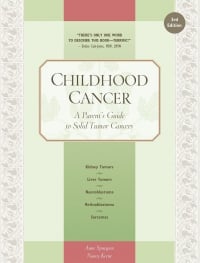Childhood Cancer
Colony-stimulating factors
Colony-stimulating factors (CSFs) are often used for children with solid tumors. Highdose chemotherapy reduces the number of white blood cells needed by the body to fight infections. The administration of CSFs, such as granulocyte colony-stimulating factor (G-CSF, also known by the brand name Neupogen®) and granulocyte-macrophage colony-stimulating factor (GM-CSF, also known as sargramostim, or by the brand name Leukine®), can reduce the severity and duration of low white blood counts, lessening the chance of infection. G-CSF may be administered by IV or by subcutaneous injection. GM-CSF must be administered by subcutaneous injection.
Kenny was only 2 years old when he was receiving G-CSF, so he was too young to understand why he needed the shots. He would cry and beg us not to hurt him—that he was sorry. My heart would break, but I would have to give him the shot. We finally developed a really good system. Right before being discharged after a round of chemo, we would put EMLA® on Kenny’s arm and then have the nurse place an insulflon. It was a small catheter that Kenny didn’t even notice was in his arm. It was good for 7 to 10 days, which was the duration of his G-CSF for the entire month. We would draw up the amount needed for injection, then place it in the insulflon and inject it very slowly. Kenny never felt it and no longer begged us not to do the G-CSF. Oh, how I wished we had done this from the beginning! Kenny’s counts would usually start to decline about 4 days after his chemo. At about Day 10 the G-CSF would kick in, and his counts would skyrocket.

Katie had no side effects from Neupogen® that I can recall. The worst thing about it for us was giving the shots at home. They’re subcutaneous, so the needle is short, but Katie still said they hurt, even with EMLA®.
Table of Contents
All Guides- Introduction
- 1. Diagnosis
- 2. Bone Sarcomas
- 3. Liver Cancers
- 4. Neuroblastoma
- 5. Retinoblastoma
- 6. Soft Tissue Sarcomas
- 7. Kidney Tumors
- 8. Telling Your Child and Others
- 9. Choosing a Treatment
- 10. Coping with Procedures
- 11. Forming a Partnership with the Medical Team
- 12. Hospitalization
- 13. Venous Catheters
- 14. Surgery
- 15. Chemotherapy
- 16. Common Side Effects of Treatment
- 17. Radiation Therapy
- 18. Stem Cell Transplantation
- 19. Siblings
- 20. Family and Friends
- 21. Communication and Behavior
- 22. School
- 23. Sources of Support
- 24. Nutrition
- 25. Medical and Financial Record-keeping
- 26. End of Treatment and Beyond
- 27. Recurrence
- 28. Death and Bereavement
- Appendix A. Blood Tests and What They Mean
- Appendix B. Resource Organizations
- Appendix C. Books, Websites, and Support Groups

